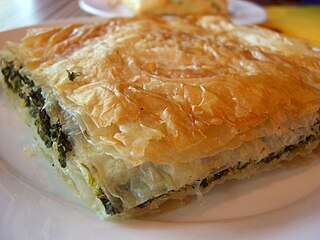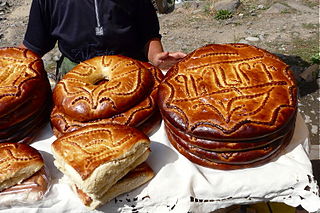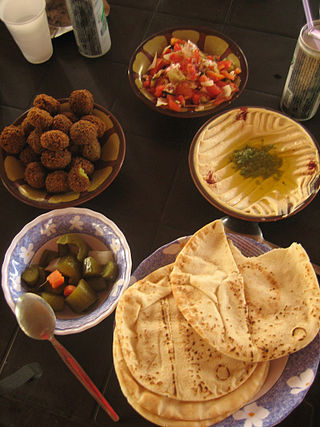
Pastry refers to a variety of doughs, as well as the sweet and savoury baked goods made from them. These goods are often called pastries as a synecdoche, and the dough may be accordingly called pastry dough for clarity. Sweetened pastries are often described as bakers' confectionery. Common pastry dishes include pies, tarts, quiches, croissants, and pasties.

Savory spinach pie is a pastry eaten throughout Southeastern Europe. The filling is made of chopped spinach and usually feta or white cheese, and egg.

Pirozhki are Eastern European baked or fried yeast-leavened boat-shaped buns with a variety of fillings. Pirozhki are a popular street food and comfort food in Eastern Europe.

Lavash is a thin flatbread usually leavened, traditionally baked in a tandoor or on a sajj, and common to the cuisines of South Caucasus, West Asia, and the areas surrounding the Caspian Sea. Lavash is one of the most widespread types of bread in Armenia, Azerbaijan, Iran and Turkey. The traditional recipe can be adapted to the modern kitchen by using a griddle or wok instead of the tonir.

Nokul or lokum is a type of puff pastry from the Turkish cuisine. It is common in the Central Black Sea Region of Turkey and the Turkish-minority areas of Bulgaria with variations. Nokul is sometimes served hot as an appetizer instead of bread. It consists of a rolled sheet of yeast dough onto which feta-style white cheese, walnut or poppy seed is sprinkled over a thin coat of butter. The dough is then rolled, cut into individual portions, and baked.

Melonpan, also called melon bun or melon bread, is a Japanese sweetbun covered in a layer of crispy cookie dough. The texture resembles that of a melon, such as a cantaloupe. It is not traditionally melon-flavored.

Börek or burek is a family of pastries or pies found in Ottoman cuisine. The pastry is made of a thin flaky dough such as filo with a variety of fillings, such as meat, cheese, spinach, or potatoes. A borek may be prepared in a large pan and cut into portions after baking, or as individual pastries. They are usually baked but some varieties can be fried. Borek is sometimes sprinkled with sesame or nigella seeds, and it can be served hot or cold.

Tulumba or Bamiyeh is a deep-fried dessert found in Egypt, Turkey and the regional cuisines of the former Ottoman Empire. It is a fried batter soaked in syrup, similar to jalebis or churros. It is made from unleavened choux pastry dough piped with a pastry bag using an open star or similar tip. It is first deep-fried to golden colour and then sugar-sweet syrup is poured over it when still hot. It is eaten cold.
Armenian cuisine includes the foods and cooking techniques of the Armenian people and traditional Armenian foods and drinks. The cuisine reflects the history and geography where Armenians have lived and where Armenian empires existed. The cuisine also reflects the traditional crops and animals grown and raised in Armenian-populated or controlled areas.

Gata is an Armenian pastry or sweet bread. There are many variations of gata in Armenia. Typically, specific towns or regions will have their own version. It can be found in a variety of shapes, sizes and may be decorated or left unadorned. Long ago, gata was baked in a tonir, but it is now baked in ovens. The bread is traditionally eaten at the feast of Candlemas, but is eaten during other festivities too or simply baked to enjoy with a cup of tea or coffee.
Gata or GATA may refer to:

Khachik is a village in the Areni Municipality of the Vayots Dzor Province in Armenia, located on the Armenia–Azerbaijan border. The village is the home to the fourth Infantry unit of Vayk Brigade.

Baklava is a layered pastry dessert made of filo pastry, filled with chopped nuts, and sweetened with syrup or honey. It was one of the most popular sweet pastries of Ottoman cuisine.

The poppy seed roll is a pastry consisting of a roll of sweet yeast bread with a dense, rich, bittersweet filling of poppy seed. An alternative filling is a paste of minced walnuts, or minced chestnuts.

Jordanian cuisine is a Levantine cuisine developed over time in Jordan. Stuffed vegetables are common, with many different techniques employed in their preparation. Meat is an important component of Jordanian cuisine, most often lamb, beef and chicken but also goat and camel meat. Rice is frequently served as a side dish but there are also one-pot rice dishes such as maqloubah.

A tandoor is a large vase-shaped oven, usually made of clay. Since antiquity, tandoors have been used to bake unleavened flatbreads, such as roti and naan, as well as to roast meat. Tandoors are predominantly used in Western Asia, Central Asia, South Asia, and the Horn of Africa.














